Forest & Shade Tree – Insect & Disease Conditions for Maine
June 17, 2021
Wayne Searles, our field technician out of New Gloucester had a day in the field that reminded him of the Morton Salt slogan—"When it rains it pours”, but not in the positive light the salt sellers intended. No, he wasn’t in Downeast Maine when nearly six inches of rain fell in a morning, but it was the same day. He was in York and southern Oxford Counties assisting with releases of emerald ash borer parasitoids. I think all in the Insect & Disease Management (IDM) Unit would agree, it has been a month like that. What prompted the feeling for Wayne was when an emerald ash borer adult joined his lunch break (so yes, the models are right, they are flying in southern Maine) followed by stumbling on extensive, and up to that date unreported, gypsy moth defoliation in the Fryeburg-Brownfield area.
This month we’ve been responding to a number of forest health issues: the public becoming increasingly aware that we are in the midst of a browntail moth outbreak, many people realizing for the first time that the caterpillars are there when they notice their treetops have no leaves, or they get a mystery rash; the sobering news of beech leaf disease arrival in Maine, and with the initial detection, recognition of a broad swath of damage; the first reports of extensive winter moth-related defoliation on Mount Desert Island, which was expected but unwelcome; a resurgence in the oak leafrolling weevil, a native species with occasional outbreaks; multiple reports of heightened forest tent caterpillar activity; heavy defoliation due to white pine needle damage in the range of white pine in Maine, especially in the southeast; and witness to the first insecticide applications to control spruce budworm since the collapse of the last outbreak. It’s been a month to remember already, and we’re only halfway through.
All this is happening as we are working to fill vacancies in our Office Associate and an Entomology Technician position. My staff and I are working hard to respond to requests in a timely way, but some will fall through the cracks. Please be patient with us, and if you don’t hear back in a couple of days, please reach out again. If you get your answer from someone else, please let us know so we don’t spend precious time getting an answer to your inquiry. We do want your reports, we need your reports, but we are under extreme pressure from multiple demands.
Thank you,
Allison Kanoti Director of Forest Health and Monitoring
Kaitlyn Whittemore has resigned from her Office Associate position. It is tough to say enough good things about Kaitlyn’s work in her short time with us. She will be missed, and we wish her well in her new adventures. In the time since Kaitlyn has been out, Mary Casey and Kevin Drake of the Forest Protection division in Ashland have assisted our IDM unit by fielding calls to the (207) 287-2431 number. This help has been invaluable. It has likely been an eye-opening experience. We hope the burden of these calls eases as the browntail and winter moth caterpillars pupate, and that we can soon fill the Office Associate position and take back the phones.
Beach Bodies (Adelgidae)
The initial report of kelp flies (Diptera) washing up on the beaches of Maine fingered the wrong order of insects. A collaborative identification effort between IDM and the State Pest Survey Coordinator in Horticulture landed on Adelgidae as the likely family (Order Hemiptera, formerly Homoptera). The USFS expert in adelgids, Nathan Havill, confirmed that as a good bet and offered to provide further identification services. Whether the sample received at the lab was representative of what was blackening the feet of visitors to beaches from MA to ME or not is not certain, but the composition of the sample received in Augusta was relatively uniform. The sample has been sent off for DNA Barcoding and we hope to have a more precise answer to the mystery soon.
 One of the adelgids in the sample submitted from a Maine beach.
Browntail Moth (Euproctis chrysorrhoea)
Much has happened with browntail moth (BTM) since our last Conditions Report. Many of the browntail host trees (especially oaks and fruit trees) are completely defoliated. In general, trees are fairly tolerant of defoliation and most will send out another flush of leaves later in June or early July after the caterpillars are finished feeding. This is especially true of trees for which this is the first season of defoliation. That being said, most areas impacted by browntail caterpillars are suffering from a lack of precipitation over an extended period, including some periods of drought. This is an added stress for these trees and may impact their ability to recover. For trees where it is possible, supplemental watering during weeks without rainfall can help support their ability to recover from defoliation.
MFS staff made observations of the first caterpillars pupating at all of our monitoring sites last week. This week, all sites had reached 100 percent pupation. This is a couple of weeks earlier than has been seen in the past (June 26 last year). This is not terribly surprising given that the growth of caterpillars has been advanced this year; likely due to a warmer spring which allowed them to emerge and begin feeding earlier and develop more rapidly. At this stage, insecticide control operations are not recommended. It is a far better investment, and a better choice for the environment, to target controls for the generation that will begin to develop in August. These control measures should include removing and destroying winter webs where possible and management with insecticides if chosen. We recommend working with licensed pesticide applicators for the latter approach.
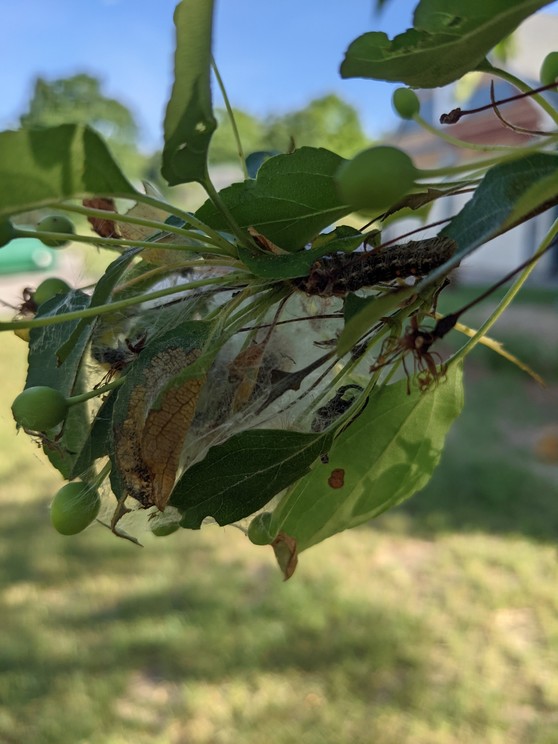 Browntail moth pupal cocoon in Cumberland, ME.
As a reminder, the coarse silk cocoons surrounding the pupae contain the last cast skin of the caterpillar, or caterpillars, and are full of toxic hairs. Many people become exposed to the hairs through encounters with the cocoons. Cocoons may be found on buildings, vehicles/ trailers and other outdoor equipment as well as plant stems, branches and foliage. Check vehicles, trailers and other materials for cocoons before moving them to prevent browntail from hitching a ride.
Some good news for tree health is we have noticed some of the trees at our monitoring sites that were completely defoliated have begun to flush out new leaves. Rain in the next couple of weeks could help most of the drought-stressed trees overcome the defoliation caused by BTM caterpillars.
We have found very small and isolated pockets of a BTM-pathogenic fungus and what looks to be the baculovirus associated with BTM in Belfast, Liberty, Jefferson, Blue Hill, Readfield and Dresden; they are likely found in many places in between. What this tells us is that the fungus and virus are very widespread, but in order for these pathogens to spread and make a big impact on populations we really need wet weather in May and June. In collecting some of the diseased caterpillars at our monitoring sites for use in future assisted disease dispersal work, we have found both parasitoid wasp larvae as well as some fly puparia within the collecting containers.
People in areas with browntail moth populations (PDF | 640 KB) should take precautions to minimize exposure to the caterpillars’ hairs. We encourage people to review suggestions to avoid contact with the caterpillar hairs. Visit our browntail moth webpage for the latest information on this pest.
Emerald Ash Borer (Agrilus planipennis)
Emerald ash borer (EAB) continues to be found in new locations in southern Maine. Bridgton and South Portland in Cumberland County are the towns where EAB has most recently been confirmed. As mentioned in the introduction, field observations have confirmed adult EAB adults are already emerging in Maine. We cannot stress enough that movement of ash should be reduced as much as possible during the active flight season, and strongly remind you that no regulated ash items may leave Maine’s quarantine areas (see map below) at any time without a state-issued compliance agreement.
 In cooperation with the USDA – Animal and Plant Health Inspection Service, MFS has begun releasing three species of parasitoids to help in the long-term control of EAB in southern Maine. In 2020, only one species was available to us, but this year we expect to receive all three: Oobius agrili, Spathius galinae, and Tetrastichus planipennisi. These tiny parasitoids attack only EAB and we hope they will establish and multiply over the coming years. Although we cannot release these in sufficient number to protect the mature trees currently standing, there is evidence from other states that they can quickly multiply in the presence of EAB and protect seedling and sapling ash as well as future ash.
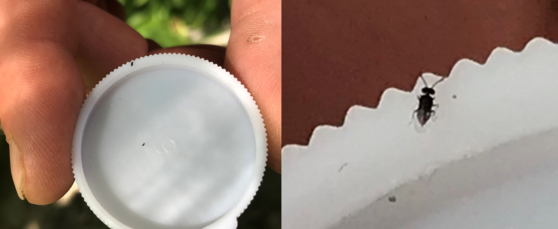 Tiny EAB egg parasitoid, Oobius agrili.
Forest Tent Caterpillar (Malacosoma disstria)
Although so far browntail moth caterpillars have been the most noted defoliator of 2021, other species such as forest tent caterpillar (FTC) are also being noticed now that larvae are more mature. Forest tent caterpillar is a native defoliator and rarely causes significant damage, however it does undergo periodic outbreaks. The last significant pocket of FTC defoliation in Maine occurred several years ago and over a period of several years along the Mines Rd in Blue Hill (Hancock County), as evidenced now by the many dead oak trees found in this isolated outbreak area. As quickly as it appeared, the population suddenly collapsed and vanished with hardly a trace from one year to the next. We have received reports of hardwood defoliation by this caterpillar in Aroostook County in northern Maine, which could be indicative of the beginning of an outbreak in that region. It appears that FTC has already pupated in these areas, so the damage should remain minimal for 2021. Please refer to the picture below to see what this common and easily identifiable caterpillar looks like. If you happen to see or have seen these caterpillars affecting a large area of forest, please report it.
 Distinctive forest tent caterpillar.
Gypsy Moth
Gypsy moth caterpillars are also just recently becoming large enough and inflicting enough defoliation damage to make it onto people’s radar. Areas with significant defoliation in Brownfield and Fryeburg were reported last week by our field technician covering western Maine, with more reports expected in the coming days and weeks. We were already aware of a greater number of egg masses than usual in western Maine this past winter, however the extent of GM damage in Maine this season remains to be seen. Outbreaks of this insect tend to occur on a roughly ten-year cycle in Maine (PDF | 516 KB), making our forests overdue since the last significant populations caused extensive damage in the early 2000s. Dry spring weather contributes to buildup of this invasive defoliator. A fungal disease impacting gypsy moth caterpillars is one of the agents important in keeping their populations low.
Hemlock Woolly Adelgid (Adelges tsugae)
This year we have been receiving more calls from the public about hemlock woolly adelgid (HWA) than ever before. There are two factors contributing to this apparent increase in HWA. One is that the past two winters have been mild resulting in low HWA winter mortality and leading to increases in HWA populations. The other is that drought conditions in recent years are adding to the stress of hemlock trees, causing them to succumb to HWA more rapidly.
The options for protecting hemlock trees from HWA are limited. The predatory beetle, Sasajiscymnus tsugae, can be bought by landowners, but is very expensive and tends to disperse from its release location. A permit from Inland Fisheries and Wildlife is required for release of this insect in Maine and we encourage landowners or managers considering this approach to work with us for permitting. It is unlikely that the release of predators alone will maintain the health of hemlocks on a property.
The only control method with any certainty of keeping hemlocks healthy in the presence of heavy HWA populations is the use of pesticides. If a tree is small enough to be thoroughly drenched, horticultural oil or insecticidal soaps can be used once or twice a year to achieve control. For larger trees, where this is impractical or too expensive, a systemic pesticide may be used. Products containing the active ingredient imidacloprid can be used to maintain hemlock health. Properly managed, this insecticide is compatible with the release of insects for biological control. All label directions must be followed, in particular, care must be taken not to exceed the per-acre label rates or apply in manner in which insect-pollinated plants take up the product and expose pollinator populations.
More information about managing hemlocks threatened by HWA and can be found in the management guide on our website (PDF |13 MB). Please continue to report HWA sightings in new areas.
Oak Leafrolling Weevil (Synolabus bipustulatus)
We have received several reports of oak leafrolling weevils. Jack Witham with the Holt Research Forest in Arrowsic has reported significant defoliation associated with this native insect and retired entomologist Charlene Donahue reported notable populations in Brunswick and an observation from Biddeford. Additionally, a photo from the Maine Entomological Society Facebook Group points to activity in Buxton and there have also been reports from a landscaper in the Westbrook area. Southeast New Hampshire also has notable populations.
Charlene included in her report from Brunswick that there was an outbreak of this weevil in 2005, which caused significant defoliation on Mount Battie in Camden Hills State Park. Populations collapsed after a single season of recorded defoliation. An area that underwent a winter harvest on the Holt has significant defoliation. The weevil activity may not have been readily apparent prior to the harvest, however the harvest concentrated weevils on the remaining oak trees. At the time of harvest, the next generation would have been overwintering in the leaf litter. Areas outside the harvest area had lower levels of impact.
One reason it is recommended to delay harvests during times of insect outbreaks is because the insects can be concentrated on the residual trees. Unfortunately, sometimes those outbreaks can be difficult to recognize as was undoubtedly the case in Arrowsic. Given this heads up, stands heavy to oak with planned partial harvests should be scrutinized for presence of this pest the summer before harvest.
Charley Eisemann has a great blog post on this species, and Colin Purrington has an informative post on its cousins. This group of weevils has some fun vocabulary to go along with it. The nidus is the bedroll/lunchbox the weevil makes for its offspring, and nidification refers to the building of said roll.
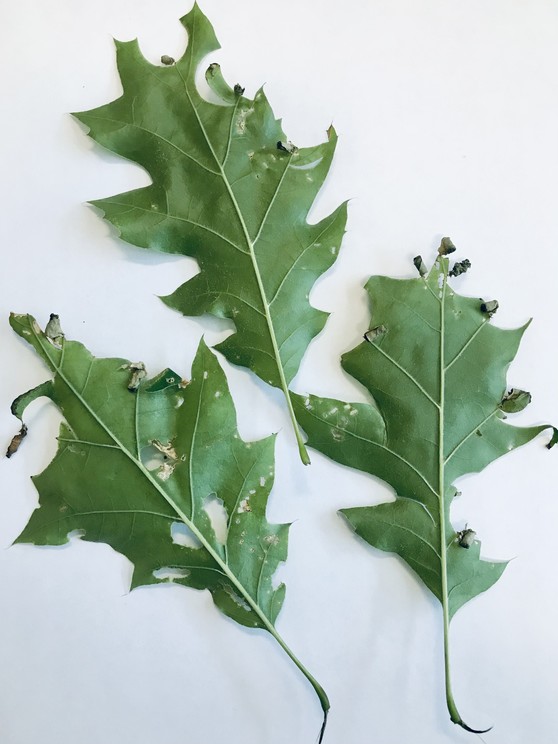 Leaves damaged by the oak leafrolling weevil.
Spruce Budworm (Choristoneura fumiferana)
We have another exciting tool in the world of spruce budworm (SBW) monitoring in the form of two automated camera traps provided to us by the Canadian Forest Service. These traps function in the same way as our pheromone traps, however they provide real-time information by logging daily photos of the collection container, allowing us to know how many moths have been caught each and every day. This will be an important tool for determining when to start and end our trapping season here in Maine, especially if changing climate changes cause the beginning of our historical trapping season to move up in the season.
Automated spruce budworm camera trap supplied by the Canadian Forest Service for monitoring timing of flights in Maine.
In other SBW news, aerial spraying has been conducted for the first time on private lands in northern Maine since the last major SBW outbreak decades ago. Initial reports indicate there appears to be good success, with dead SBW larvae well-documented. This spraying strategy, modeled on the EIS (early intervention strategy) being used against SBW in Atlantic Canada, is designed to bring SBW populations back down early on in an outbreak to allow population controls such as predators and parasitoids to retake the upper hand at natural population suppression. Spruce budworm pheromone traps are being installed all across Maine throughout late June by a network of cooperators, to get a broad look at potential populations for 2022.
Winter Moth (Operophtera brumata)
On May 25, MFS staff collected winter moth caterpillars to further our biocontrol program. Caterpillars were collected at some of our previous release sites including Fort McClary State Park, Two Lights State Park, Harpswell, South Portland and Bath. A portion of these caterpillars are infected with a parasitoid fly called Cyzenis albicans (the proportion of parasitism varies by location), which is the most effective and specific biocontrol for winter moth. Caterpillars were harder to come by as has been the case for the past couple of years. The caterpillars we collected have since pupated and will be sent to our collaborators at the University of Massachusetts at Amherst to determine the percentage of parasitism and will be returned to Maine to serve as our next biocontrol release. Reports of winter moth defoliation have come in from the Boothbay Harbor regions, Kittery, a few of the islands off the coast of Portland including Cushing, Peaks, the Diamonds and Chebeague Island as well as Bristol and Mount Desert.
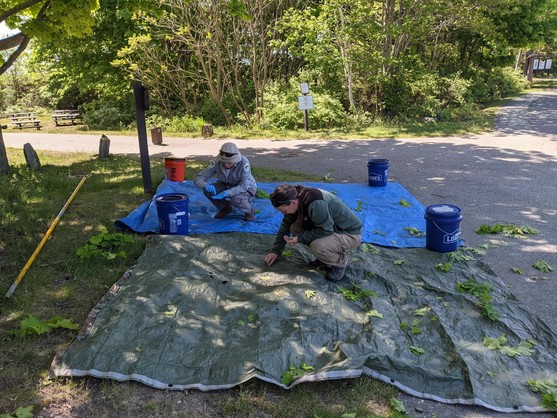 Winter moth caterpillar collection in Cape Elizabeth at Two Lights State Park.
Beech Leaf Disease (Litylenchus crenatae; possibly other organisms are involved in the disease complex)
Beech leaf disease was confirmed in leaf samples from a forest in Lincolnville, ME (Waldo County) by Dr. Robert Marra of Connecticut Agricultural Experiment Station. The diseased trees were brought to the attention of the Maine Forest Service Pathologist by the landowners, who pay attention for changes in their frequent walks through their forest. Symptoms of the disease have since been seen in towns from Belfast to Rockport and inland to Searsmont and Hope. It appears to be widespread in the Midcoast and is likely found elsewhere in Maine.
Beech leaf disease was first reported in Ohio in 2012, and for many years it was known only in adjacent states and provinces. 2019 marked the first detections of the disease in eastern New York, and in 2020 a concerted survey and outreach effort uncovered the disease in southern New England and other areas.
Symptoms of beech leaf disease include:
- Dark bands form between the veins of leaves;
- Leaves become curled, deformed, and shriveled;
- Trees develop a thin canopy.
Maine Forest Service will continue to monitor developments as more is learned about this disease. However, at this time, there are no proven methods for management. We are asking the public’s help in identifying additional areas impacted by beech leaf disease. Photos of leaves and trees suspected to be impacted by the disease can be submitted in our online form; reports can also be made to foresthealth@maine.gov or by calling (207) 287-2431. If possible, photos should include a clear shot of the underside of an affected leaf or leaves, however, please report concerns even if those photos cannot be provided.
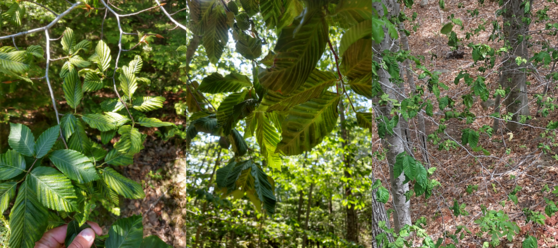 (left) Small, leathery and deformed leaves impacted by beech leaf disease; (middle) Severe banding pattern typical of beech leaf disease as seen looking up from the lower canopy; (right) Leaf drop, bud mortality and branch dieback symptoms of beech leaf disease.
Bot canker of oak (Diplodia spp.)
Bot canker symptoms were recently seen in red oaks in southwestern Maine. Symptoms include dead branch tips, usually confined to twigs and small diameter branches with cankers near the base of symptoms. However, larger branches were seen affected in some trees causing significant branch dieback. Also, even sapling mortality was noted to be associated with bot cankers. Increased damage from Bot canker is often associated with other stressors. In southwestern Maine, a very likely source of stress was last year’s drought conditions.
 (left, arrows) Flagging oak branch tips caused by Bot canker; (top right, arrow) a bot canker at the base dead branch tip symptom; (bottom right) close-up of small diameter branches with Bot cankers.
Drought
According to the National Drought Monitor, much of Maine is experiencing abnormally dry or moderate drought conditions. The effect on trees, especially those already impacted by other stressors and agents of decline, is detrimental and could lead to dieback and in some cases mortality. Where practical, newer plantings and trees impacted by other tree disorders should be given water to help them better cope with difficult growing conditions.
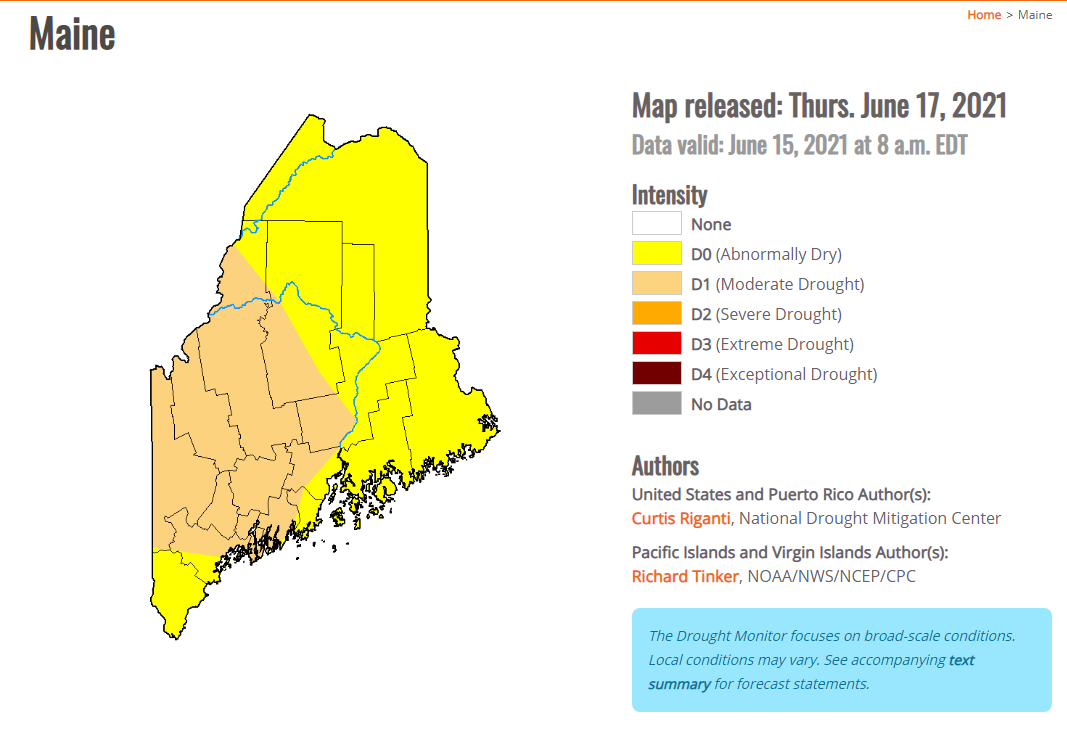 Image: U.S. Drought Monitor map. National Drought Mitigation Center
Maple Anthracnose (Aureobasidium apocryptum, Discula campestris and Colletotrichum gleosporoides)
Since mid-May, increasing reports of maple leaf disorders have been received at the Lab. The reports have described leaves that have partly or completely turned black, curled and have dried out. In some extreme cases, large amounts of leaves have prematurely fallen from trees. Based on images sent with the reports and several field visits, the disorder was determined to be maple anthracnose. Maple anthracnose is a fungal disease affecting maple leaves of all native and non-native maples that can grow in Maine.
 Three images from a tree with a moderate amount of black leaf lesions caused by a maple anthracnose fungus, likely Aureobasidium apocryptum.
Although the leaf symptoms can look quite severe, the disease is typically only an aesthetic issue for established trees. Mature trees very seldom die, even from repeated years of heavy infection and leaf loss. However, newly planted maples may be harmed. Newer maple plantings can be protected with fungicide from budbreak into summer, but supplemental water and nutrients to promote tree vigor can be enough to help impacted trees recover.
Initial infections originate from fungal lesions on fine twigs and branches from the previous year. Subsequent infections from spore-producing structures on leaves can perpetuate infections. Further, spore production of the fungi is highest in spring and tapers off with the progression of the summer season, so removing the infected prematurely defoliated leaves from the area is an important management tactic.
The peculiar thing about the high occurrence of maple anthracnose in Maine this spring is that anthracnose diseases usually are more prevalent during years with longer periods of wet weather in spring/early summer, which Maine has not experienced this year or last year. Most fungi are highly dependent on high relative humidity (rain, fog, sprinkler systems that keep tree parts wet for prolonged time periods). Thus, the anthracnose infection of 2021 must be the result of perfectly timed high-moisture events during maple bud break and expansion – which not surprisingly is the time the fungi responsible for maple anthracnose disease are ready to produce spores. Additionally, some observation and reports indicate that oak anthracnose disease may be severe in some areas as well.
White Pine Health Concerns
Aerial survey in the southwestern part of Maine recorded large areas of white pine that appear to be in very poor condition with thin crowns and discoloration of the whole crown. This information has been supported by reports from the public. In some locations the live crown ratios of trees are in single digits, which often indicates trees are in steep decline.
Reports and observations from Central Maine and the Midcoast region have confirmed that white pines are struggling in those areas as well. A disease complex (a disease consisting of more than one organism) called white pine needle damage (WPND) has been impacting white pines in Maine for over a decade. The life cycles of the needle cast fungi involved in the WPND complex are such that needles do not show symptoms until the year after they are infected and the responsible fungi are dependent on prolonged periods of moisture for spore production and infection. Thus, WPND damage was expected to be low in 2021 due to the lack of rain in the spring of 2020. However, the symptoms in 2021 appear to be more severe than in previous years.
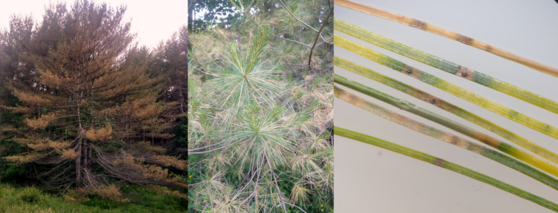 (left) Severe WPND symptoms on eastern white pine tree in Union, Maine; (middle) Foliage showing discoloration and disease symptoms in second- and third-year needles, with asymptomatic new growth; (right) brown spot needle blight lesions on needles, one of the pathogens in the WPND complex.
One theory is that the long abnormally dry period during the 2020 growing season and the dry weather so far this spring are factors making symptoms worse, further stressing white pines. Additionally, white pine growing in open areas, near roads and forest edges seems to be the worst affected, possibly due to more droughty conditions, and specifically in the case of roadside trees, exposure to road deicing materials over the winter. Symptoms can be more extreme when combined with additional disorders. Despite the poor appearance of the white pine in these areas, we cannot predict the potential for tree mortality, but it seems reasonable to expect that some trees in the worst areas with the lowest amounts of living crown may not recover from this stress.
Details of upcoming events can be found by visiting https://www.maine.gov/dacf/mfs/events.html
Conditions Report No. 3, 2021
Department of Agriculture Conservation & Forestry
Maine Forest Service – Forest Health and Monitoring
Contributors: Aaron Bergdahl, Allison Kanoti, Mike Parisio, Thomas Schmeelk, and Colleen Teerling
Unless otherwise noted, photos by Maine Forest Service, Forest Health and Monitoring, DACF
|